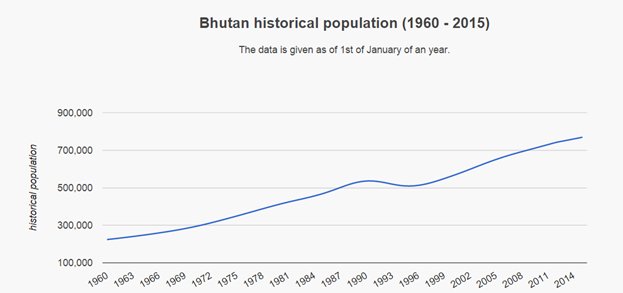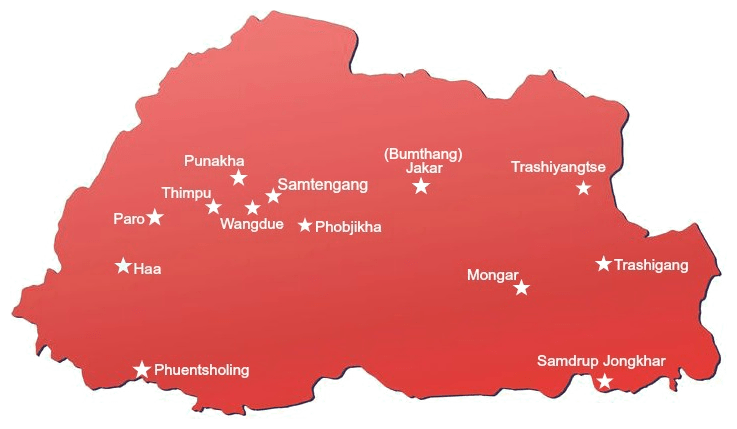Bhutan Tourism left no stone unturned
Bhutan, a mountainous country is a hub of history, culture, food and tourism. The tourists are awed at the modernity and the tradition that Bhutan holds. Thevibrant culture is radiated all over the place. It is bordered on the east and north by Tibet and located on the south-east of the Himalayas. The landscape comprises of deep valleys and mountains and it is the best tourist destination for more than 30 years.
Bhutan’s vibrant History
Ancient History of Bhutan has an array of diversification and rich culture emergence. In 17th Century, the place was known as the Land of Thunder Dragon while in the outside world it was recognized with the name “BHUTAN” commonly derived from the Sanskrit word called Bhu-Uttan meaning High Land.
Bonism was the major religion in Bhutan till the time an Indian Glorified soul Guru Padmasambhava, also known as Guru Rimpoche got Buddhism to Bhutan. Many battles were fought against another ruled Bhutan till the dual system of governance emerged in 1616 A.D by Zhabdrung Ngawang Namgyal. After the death of Zhabdrung in the year 1651, the power was consolidated to the first Hereditary Monarch “ GongsarUgyenWangchuck” in 1907.
This monarchical system remained till 2008 before the democracy was introduced in Bhutan. Today Bhutan is a well-known Democratic Constitutional Monarchy.
Bhutan estimated population is about 800,000 people with country area of 18,217 square miles (47,182 square kilometers) which lies in the east of Himalaya Mountain Range. There is a subsequent increase in population of 1.20 % from the previous year growth rate.

Bhutan’s population can be categorized on the basis of three main ethnic groups: the Bhutia, Assamese and Nepalese. Bhutia caters to roughly 50 % of Bhutan’s population, Assamese account to 15% of the in habitants while the Nepalese are 35% of the Bhutan’s population. The climate of Bhutan is moderate supported with agriculture near the valleys.
Bhutan’s official language is Dzongkha identical to Tibetan. Other languages like Nepali, Gurung and Assamese are also the part of linguistic culture of Bhutan.
A famous Buddhist philosopher explains that culture does not lie in monuments but in the right minds full of compassion. Bhutan is well known for its deep rooted cultural heritage and has grown in its values and traditional beliefs. The place is the tourist attraction for many by indulging themselves in its magnificent architecture, clothing, tradition and archery. The ancient art and modern pieces in Bhutan are balanced to keep up the taste of the Bhutan’s culture and its traditional way of living. The dzongs and monasteries are the centre of attraction for tourists and these help in nurturing the Bhutan’s culture all over the globe.
Women in Bhutan are skilled weavers. Embroidery is just an art for making tablecloths, clothing,religious items, and even bedding. The religious festivals are celebrated with ritual music and dance. The costumes of the dance performance are the creative work and effort that goes in the making of the magnificent piece of art.
The National dress of Bhutan also known as DriglamNamzha is the most distinctive aspects of Dragon Land’s unique character. Males wear Gho, very similar to Tibetan Chhuba while women wear kira, an ankle length robe. The Bhutanese textile is made up of woven fabric, fine with various colourful patterns.
The country’s prosperity is dependent upon the citizen’s happiness and not on the GDP growth.
In 1971, Bhutan rejected GDP as the only system for evaluating country’s economic growth. With this, Gross National Happiness came into being to measure the prosperity through its principles. This would also evaluate the environmental, spiritual,social and physicalstatus of the citizen.
The major four principles of GNH are as follows:
- Sustainable development – The core of Bhutan’s development policy is the social and economic development of the country. It provides with the high level of living, good education and social services.
- Promotion and preservation of cultural values and traditions- GNH is also about the culture of the individual, their life in the community and our society.
- Conserving natural environment- Presently, Bhutan accounts to 72% of the forested area and 1/3rd of the country falls within the protected area. For effective conservation of biodiversity, we need to understand what we have and what should be the access for conserving natural environment.
- Establishing good governance– Government will take preliminary actions towards the change but the support of the country citizens and their proactive nature towards these exciting changes is essential.
Bhutan has always prioritize the happiness of its citizens above the country’s economic growth. Gross National Happiness is based upon the fact that development occurs when the physical and mental health of the citizen is considered
An attractive tourist places are explored from a strand of ancient monasteries to modern places. Bhutan has emerged into a remarkable and dynamic destination offering numerous sightseeing activities.
Get close to the country’s cultural values and explore the destination for a razzle-dazzle experience!

